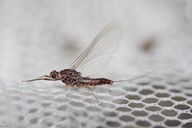Uno & Pneh, 2020
Effect of source habitat spatial heterogeneity and species diversity on the temporal stability of aquatic‐to‐terrestrial subsidy by emerging aquatic insects
Uno, H., and Pneh, S. (2020)
Ecological Research 35 (3): 474–481
-
Eel, GRAD STUDENT
Abstract
Duration and temporal stability of resource subsidy largely affect the response of recipient communities. Factors that influence the temporal dynamics of resource subsidy from aquatic‐to‐terrestrial habitats by emerging aquatic insects were examined in this study. By measuring the flux of aquatic insect emergence from six habitats in a river over summer, we found that the timing of emergence varied by habitats for each dominant taxa, and that different species emerged at different times of the summer sequentially. We found that spatial variation in the emergence timing caused by the spatial heterogeneity of the water temperature, and so on in the source habitat can temporally stabilize the subsidy of each species from the whole river. Similarly, we found that the variation in emergence timing between species contributed to the temporal stability of subsidies from each habitat. The contribution of spatial heterogeneity to the temporal stability varied by the focal species and the contribution of species diversity varied by habitats. This study demonstrates how the ecological function of spatial heterogeneity and species diversity crosses the boundary of ecosystems by temporally stabilizing resource subsidies.
Citation
Uno, H., and Pneh, S. (2020): Effect of source habitat spatial heterogeneity and species diversity on the temporal stability of aquatic‐to‐terrestrial subsidy by emerging aquatic insects. Ecological Research 35 (3): 474–481. DOI: 10.1111/1440-1703.12125
 This Paper/Book acknowledges NSF CZO grant support.
This Paper/Book acknowledges NSF CZO grant support.
Explore Further


